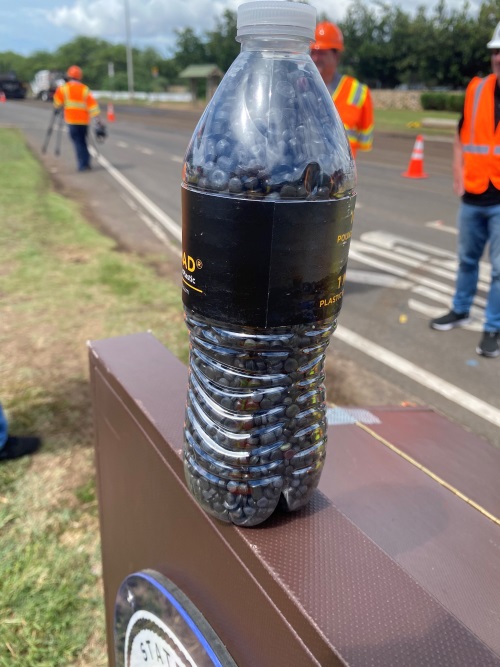The Hawaii Department of Transportation is moving forward on two fronts to transform plastic water bottles from beach-littering ‘ōpala’ or rubbish to recycled road material.
[Above photo by the Hawaii DOT]
Engineers are testing an asphalt mix with recycled plastic polymer on a 1.2-mile road segment in Honolulu to see how well it holds up in Hawaii’s tropical environment.
Meanwhile, Hawaii DOT is using an FHWA Climate Challenge Initiative grant to help finance its own $6 million plastic recycling research facility to turn plastic waste into road polymer and other useful transportation products.
The pilot project is the southern end of Fort Weaver Road; a two-lane bi-directional road with that carries 6,200 vehicles per day on average. The roadway was “perfect for the pilot” because the base structure was in good condition, but the wearing recourse required “significant rehabilitation or replacement,” said Ed Sniffen, Hawaii DOT’s deputy director of highways.
He explained that the agency plans to divide the roadway segment into three sections: the control section, which will be composed exclusively of Polymer Modified Asphalt or PMA; a second section incorporating plastic into the PMA; and a third section adding plastic to traditional ‘Hot Mix’ asphalt.
Once construction is finished in July 2023, researchers at the University of Hawaii at Mānoa and Hawaii Pacific University will evaluate the three sections for performance and the potential of the material to release microplastics into the environment.

“Even though we’re using a material that has been used on roads in the United States for over five years, we need to make sure the mix is right for Hawaii and our environment,” Sniffen said.
Anticipating that the pilot project will be a success, Hawaii DOT already is planning the state’s first plastic recycling facility, expected to be operational within two years.
The facility will use plastic waste found in the Pacific Ocean to manufacture pellets for roadway use, Sniffen noted, “then could potentially move into creating plastic products for other infrastructure like plastic reinforcing materials for concrete.”
That is important for Hawaii because it must import plastic pellets from the mainland while it has an overabundance of hometown plastic that serves no useful purpose.
“Keeping our own waste plastic out of landfills in a manner that will improve our roads and environment will be a tremendous benefit to everyone in Hawaii,” Sniffen added.
Several other state departments of transportation are engaged in similar plastic recycling efforts.
In November 2021, the Pennsylvania Department of Transportation wrapped up a pilot project that used plastic pellets made from grocery bags, milk jugs, and other recyclable plastics in an asphalt reconstruction project.
The pellets were added to the asphalt that covered two quarter-mile test sections of the project at the entrance to Ridley Creek State Park, about 15 miles west of Philadelphia.
In December 2021, the Illinois Department of Transportation started working with the Illinois Center for Transportation to develop more “sustainable pavement practices,” which include ways to incorporate more recycled materials such as plastic into asphalt mixes.
Both are working on a joint project – dubbed “R27-196-HS: Rheology-Chemical Based Procedure to Evaluate Additives/Modifiers Used in Asphalt Binders for Performance Enhancements: Phase 2” – to investigate methods to “soften” asphalt binder to reduce pavement cracking.

